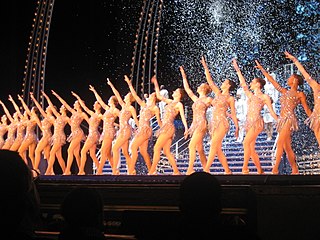
Synchronization is the coordination of events to operate a system in unison. For example, the conductor of an orchestra keeps the orchestra synchronized or in time. Systems that operate with all parts in synchrony are said to be synchronous or in sync—and those that are not are asynchronous.

Audio mixing is the process by which multiple sounds are combined into one or more channels. In the process, a source's volume level, frequency content, dynamics, and panoramic position are manipulated or enhanced. This practical, aesthetic, or otherwise creative treatment is done in order to produce a finished version that is appealing to listeners.
Sync and synch are abbreviations of synchronization, the coordination of events to keep them in time.
Mario Davidovsky was an Argentine-American composer. Born in Argentina, he emigrated in 1960 to the United States, where he lived for the remainder of his life. He is best known for his series of compositions called Synchronisms, which in live performance incorporate both acoustic instruments and electroacoustic sounds played from a tape.
Sync sound refers to sound recorded at the time of the filming of movies. It has been widely used in movies since the birth of sound movies.
Synchronicity is a concept first introduced by analytical psychologist Carl G. Jung "to describe circumstances that appear meaningfully related yet lack a causal connection."
Reconstruction may refer to:
The 1971 Pulitzer Prize went to the following:
Synchronisms is a series of twelve musical compositions for solo or ensemble live instruments and pre-recorded tape composed by Mario Davidovsky at the Columbia-Princeton Electronic Music Center, the first dating from 1963. Davidovsky explains that, "One of the central ideas of these pieces is the search to find ways of embedding both the acoustic and the electronic into a single, coherent musical and aesthetic space."
Audio-to-video synchronization refers to the relative timing of audio (sound) and video (image) parts during creation, post-production (mixing), transmission, reception and play-back processing. AV synchronization can be an issue in television, videoconferencing, or film.

In filmmaking, Foley is the reproduction of everyday sound effects that are added to films, videos, and other media in post-production to enhance audio quality. These reproduced sounds, named after sound-effects artist Jack Foley, can be anything from the swishing of clothing and footsteps to squeaky doors and breaking glass. Foley sounds are used to enhance the auditory experience of the movie. Foley can also be used to cover up unwanted sounds captured on the set of a movie during filming, such as overflying airplanes or passing traffic.
In an alternating current (AC) electric power system, synchronization is the process of matching the frequency and phase and voltage of a generator or other source to an electrical grid in order to transfer power. If two unconnected segments of a grid are to be connected to each other, they cannot safely exchange AC power until they are synchronized.
Robert Miller was an American pianist and attorney.
Synchron Stage Vienna is a recording facility specializing in recording large orchestras and film music. The landmark protected building, formerly "Synchronhalle" of the historic film lot "Film City Vienna" in the Austrian capital's 23rd district is operated by Vienna Symphonic Library.
Synchronization is the coordination of events to operate a system in unison.
This page is based on this
Wikipedia article Text is available under the
CC BY-SA 4.0 license; additional terms may apply.
Images, videos and audio are available under their respective licenses.


